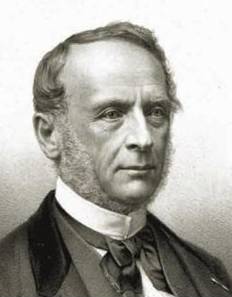JOHAN PETER EMILIUS HARTMANN

1805-1900
– progenitor of a whole dynasty in Danish cutural life
Hartmann was a composer, a performing musician and something of a star in professional circles. He was also one of the decisive figures in the Danish Romantic movement. w
Both his grandfather and his father had been violinists in the Royal Danish Orchestra. The grandfather had also been a composer, his main work being the singspiel Fiskerne (‘The Fishermen’) from 1779, set to a text by Johannes Ewald (1743-1781). J.P.E. Hartmann performed for the first time at the age of 15 in a concerto for two violins, with the ballet genius August Bournonville (1805-1879) as his partner!
For the rest of his life, he earned his living as an organist. He was employed at the church of Garnisons Kirke at the age of 19, and at The Copenhagen Cathedral in 1843, after the death of C.E.F. Weyse the previous year. His meetings with famous colleagues such as Rossini and Frédéric Chopin on his Grand Tour to Paris in 1836 also
provided him with external impulses.
J.P.E. Hartmann – the initials are pronounced “I.P.E.” – became an influential voice in many places: He was present at the founding of such illustrious institutions as the Music Society in 1836 and the Students’ Choral Society three years later. He also became a ‘co-director’
Copenhagen Cathedral in 1843, after the death of C.E.F. Weyse the previous year. His meetings with famous colleagues such as Rossini and Frédéric Chopin on his Grand Tour to Paris in 1836 also provided him with external impulses.
of the Royal Danish Academy of Music in 1867, alongside the conductor Holger Simon Paulli (1810-1891) and the Academy’s founder, Niels W. Gade himself.
Hartmann lived a long life with relatively few dramas. Incredibly, he could have met both Joseph Haydn (1732-1809) and Igor Stravinsky (1882-1971) in the street! Emma Hartmann (1807-1851) was his first wife, and was herself the composer of a number of songs under the pseudonym ‘Frederik Palmer’ in her final years. The couple’s six surviving children became the beginning of one of the greatest families in Danish cultural life, which has included such well-known names as the painter Oluf Hartmann (1879-1910), the composer Niels Viggo Bentzon (1919-2000), the film director Lars von Trier (b. 1956) and the jazz pianist Nikolaj Bentzon (b. 1964).
Liden Kirsten (‘Little Kirsten’) with Sverkel’s Romance from 1846 is one of his important works. This once beloved opera, set to a text by Hans Christian Andersen (1805-1875), was inspired by folk ballads. Many will also be familiar with the choral piece Vølvens spådom (‘Prophecy of the Seeress’) from around 1870, and songs such as Lær mig, nattens stjerne (‘Teach me, star of night’), I sne står urt og busk i skjul (‘Snow covers every plant and bush’) and Blomstre som en rosengård (‘Blossom like a rose garden’).
| Collection | Op | No | Title | Poet |
|---|---|---|---|---|
| Liden Kirsten | 44 | 7 | Sverkels Romance: Ja, jeg er hjemme | H. C. Andersen |
| Sex Sange af M. Rosing, Chr. Richardt og B.S. Ingemann | 63 | 5 | Lær mig! | Christian Richardt |